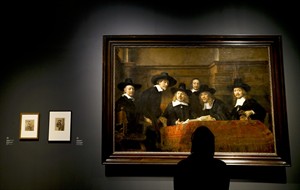
Blockbuster London exhibition argues that Rembrandt, like wine, improved with age
LONDON – There are few artists with a more famous face than Rembrandt. The Dutch master painted himself repeatedly throughout his career.
Four large self-portraits gaze at visitors entering a mammoth new Rembrandt show at the National Gallery in London. He looks by turns quizzical, stoic and defiant, and the exhibition seeks to show that even this best-known of artists was a man of surprising facets.
“Rembrandt: The Late Works” covers the 20 years before Rembrandt’s death in 1669, aged 63. It was a time of personal upheaval. Despite his renown as an artist, he struggled with debt and faced bankruptcy. His common-law wife, Hendrickje Stoffels, and his son, Titus, both predeceased him.
And yet, said curator Betsy Wieseman, it was a period of intense creativity.
“I think he was very good at compartmentalizing,” Wieseman said Tuesday at a preview for the show. “His art was certainly affected by these dramatic events in his life, but I think the art was also an escape for him, and a therapy in a way.”
Organized with Amsterdam’s Rijksmuseum — it travels there in February after its London run — the exhibition includes more than 90 paintings, drawings and prints from collections around the world.
One key painting almost didn’t make it.
“The Conspiracy of the Batavians Under Claudius Civilis” belongs to Sweden’s Royal Academy of Fine Arts and has not left Sweden in 45 years.
“The loan was only secured a couple of weeks ago,” Wieseman said. “It’s just absolutely crucial to the show and it really, really was a dramatic, last-minute Hail Mary pass.”
The painting is a survivor of a mysterious episode in Rembrandt’s career. It’s part of a huge work depicting a tribal uprising against the Romans. For the 17th-century Dutch, the episode symbolized their liberation from Spanish rule.
The work was commissioned for Amsterdam’s grand new Town Hall, but was displayed for only a few months before being removed. The reason is unknown; it’s possible the work’s intensity was too much for the burghers of Amsterdam.
As the exhibition illustrates, Rembrandt could be unflinching — there’s blood and brains galore in “The Anatomy Lesson of Dr. Joan Deyman” — but also tenderness, in delicate nudes and quiet, intimate portraits of the artist’s son.
The works on show embrace a vast array of techniques and moods. There are experiments with light and shadow; delicate drawings of Dutch forests and farms; large portraits of society worthies; scenes from mythology and the Bible.
But it’s the faces that linger in the memory.
Elderly merchant’s wife Magaretha de Geer looks like a woman not to be trifled with in Rembrandt’s portrait of her. Vanity, seriousness and detached amusement seem to flit across the faces of “The Sampling Officials of the Amsterdam Drapers’ Guild.”
Fashion designer Zandra Rhodes — subject of a Rembrandt-style portrait by photographer Rankin for a project that accompanies the exhibition — said it was the depth of Rembrandt’s images that set him apart.
“In his early life he’s like all the other Dutch painters,” she said. “And then his work gets very, very intense.”
“It’s a bit serious for me to own,” she added. “I’d rather have a Rubens.”
“Rembrandt: The Late Works” is at the National Gallery from Wednesday to Jan. 18, and at the Rijksmuseum in Amsterdam from Feb. 12 to May 17, 2015.
Follow Jill Lawless on Twitter at http://Twitter.com/JillLawless
Join the Conversation!
Want to share your thoughts, add context, or connect with others in your community? Create a free account to comment on stories, ask questions, and join meaningful discussions on our new site.












Leave a Reply
You must be logged in to post a comment.